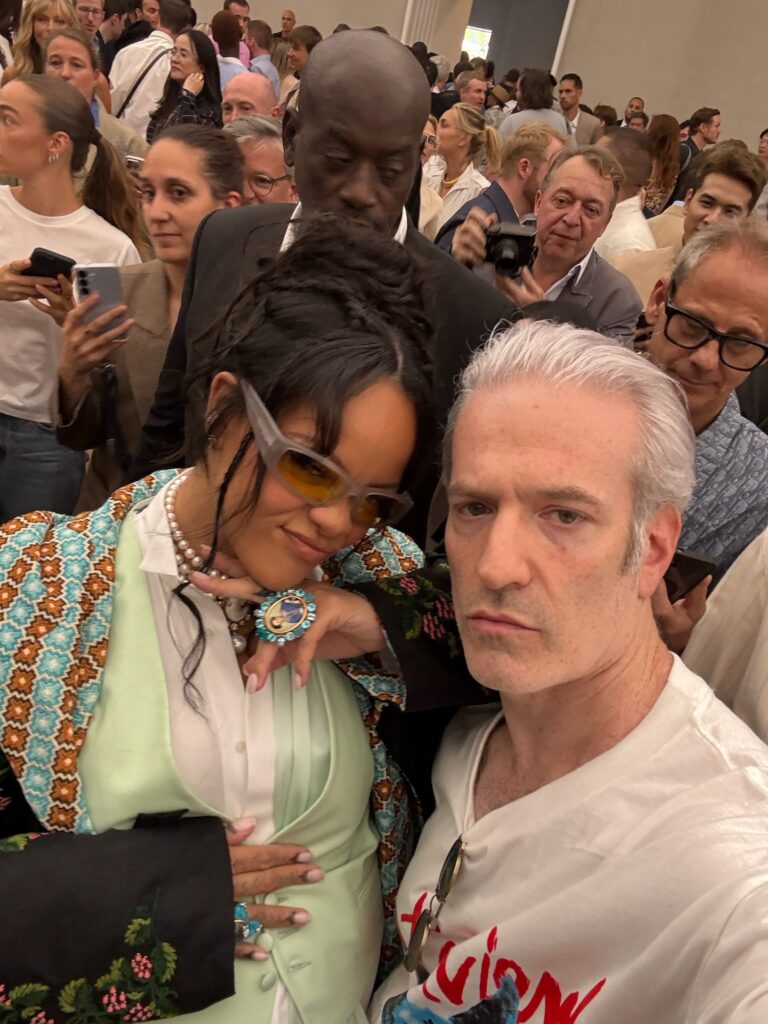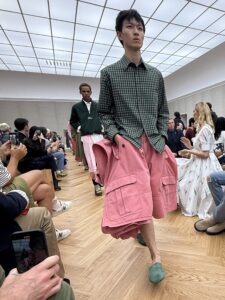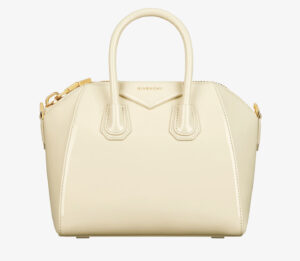
Paris has long been the epicenter of fashion’s grandest gestures and whispered revolutions. On a hazy summer evening that already promised cinematic surprises, the world gathered for what would be Jonathan Anderson’s first Dior collection — a debut that had been whispered about in ateliers and editorials for months. The city’s streets hummed with excitement, punctuated by flashes of paparazzi and the elegant hush of chauffeurs opening car doors. Yet even among all this orchestrated glamour, one question echoed through the venue’s marbled halls and around the Palais de Tokyo: “We must be waiting for Rihanna.”
There is a particular electricity in the air when a designer of Anderson’s caliber steps into a storied house like Dior. Founded by Christian Dior in 1946, the maison has witnessed countless reinventions: from Yves Saint Laurent’s groundbreaking trapeze silhouettes to John Galliano’s theatrical excess and Maria Grazia Chiuri’s feminist-driven minimalism. But Dior’s menswear line, revitalized in recent decades, always hovered at the intersection of heritage and innovation. Anderson’s appointment was nothing less than a cultural pivot, promising a collision of intellectual rigor and craft with his subversive Irish spirit.
Inside the venue, the set design hinted at a certain intimacy. Rather than the towering labyrinths or futuristic installations often favored by Dior, Anderson opted for a series of interconnected salon-like spaces, each softly lit and draped with translucent textiles. The atmosphere recalled Christian Dior’s own 30 Avenue Montaigne salons, where private clients once gathered to preview New Look collections in the late 1940s. This choice signaled Anderson’s desire to return to the roots of couture: the tactile, the personal, the almost whispered magic of fabric against skin.
As guests took their seats, the crowd itself became part of the spectacle. There was Francis Ford Coppola, a cinematic titan whose own quiet presence seemed to embody Anderson’s preference for depth over spectacle. Beside him, creative polymaths and social media stars buzzed, capturing every pre-show moment for millions waiting online. And then, of course, there was Rihanna — arguably the night’s gravitational force. When she finally appeared, wearing an embroidered jacket layered over a seafoam green waistcoat and accessorized with oversized gemstone rings and futuristic sunglasses, the room felt as though it collectively inhaled. Rihanna has that effect: she doesn’t merely attend; she transforms the atmosphere.
Jonathan Anderson’s approach to Dior menswear was immediately clear when the first model stepped onto the runway. Gone were the aggressive streetwear notes and exaggerated logos that have defined much of men’s luxury in recent years. Instead, Anderson offered a meditation on softness, fluidity, and the performative nature of masculinity. Silk waistcoats in pale mint, slouchy trousers that swayed with each step, and poet-sleeved shirts with billowing cuffs set a new vocabulary of movement. The colors ranged from luminous whites and muted seafoam to deeper mineral tones, evoking both the ocean and the iridescence of mother-of-pearl.
This collection seemed to ask: What happens when we imagine a man not as a rigid figure of authority but as a vessel of transformation? It was a question Dior himself might have admired. After all, Christian Dior’s post-war silhouettes sought to revive beauty, romance, and softness in a world that had been ravaged by conflict. Anderson’s offering, too, felt like an antidote — a subtle protest against hyper-masculine clichés and an invitation to vulnerability.
Every detail in the garments hinted at storytelling. Tiny ceramic buttons, crafted in Limoges, were individually painted to depict abstract sea creatures and ocean flora. Capes appeared in translucent silk organza, creating a ghostly shimmer as they moved under the lights. Even the footwear — softly squared loafers and slipper-like sandals — suggested domestic comfort rather than battlefield bravado. These choices underscored Anderson’s fascination with the intersection of craft and narrative, a hallmark of his work at his own label, JW Anderson, and at Loewe.
The historical echoes were everywhere. The waist emphasis nodded to 18th-century aristocratic menswear, while the fluid tunics hinted at ancient Greek chiton forms. Yet, these references never felt academic or costume-like. Anderson skillfully abstracted them into contemporary poetry, ensuring that each piece could exist as a standalone statement or meld seamlessly into a modern wardrobe.
Outside the show, conversations lingered on the guest list nearly as much as the clothes themselves. Anderson’s Dior debut drew a cultural cross-section rarely seen in one room: cinema legends, Gen-Z TikTok arbiters, global musicians, and veteran editors. It was a testament to his wide-reaching influence and his unique ability to bridge disparate worlds. Francis Ford Coppola’s quiet presence, juxtaposed against the magnetic pull of Rihanna’s arrival, encapsulated the tension between introspection and spectacle that has always animated high fashion.
Rihanna, of course, was the evening’s unofficial empress. Her choice to wear such an intricately embroidered jacket — reminiscent of both Eastern ceremonial coats and 19th-century European court dress — was a sartorial wink to the show’s themes of hybrid identity and transformation. Her layered pearl necklaces and futuristic eyewear only deepened this narrative, merging past opulence with a cosmic edge. By merely being present, she embodied the kind of fearless experimentation Anderson championed on the runway.
Post-show interviews revealed that Anderson had been quietly researching Dior’s archives for over a year before his appointment was officially announced. He delved into the maison’s rich tapestry of codes: the iconic bar jacket, the passion for flowers, the architectural lines. But he also sought inspiration beyond fashion — looking to literature, particularly Virginia Woolf’s fluid explorations of identity, and to marine biology, fascinated by the forms and colors of deep-sea life. This multidisciplinary curiosity emerged clearly in the collection’s motifs, from shell-like pleats to the aquatic palette.
As the final look vanished behind the curtains and the house lights rose, there was no explosive applause or forced standing ovation. Instead, there was a contemplative hush, followed by a slow crescendo of genuine appreciation. It felt less like the end of a show and more like the end of an opera’s first act, leaving the audience yearning for the narrative to continue.
Backstage, the mood was almost reverential. Photographers documented each detail: models still in character, delicate embroidery catching stray beams of light, the quiet pride on Anderson’s face as he embraced his team. Outside, guests spilled into the Parisian night, their voices animated but hushed, as if they had witnessed something more intimate than a fashion show — perhaps a collective moment of transformation.
Fashion critics and cultural commentators quickly took to social media and digital outlets to parse the collection’s significance. Many hailed it as a new dawn for Dior menswear, one that marries historical respect with bold conceptual play. Others pointed out its potential to inspire broader shifts in menswear design, encouraging a move away from overt aggression and towards garments that explore fluidity and nuance.
For younger audiences watching via livestream, the collection might have seemed like a gentle call to rethink self-presentation. In a world obsessed with instantaneous virality and rigid identity categories, Anderson’s Dior debut felt like a whispered invitation to softness — to embrace multiple selves, to move with grace rather than force.
What does it mean, then, to wait for Rihanna? In one sense, it’s literal: the celebrity whose arrival signals that the show can finally begin. But in a deeper sense, “waiting for Rihanna” has become a cultural shorthand for longing for an icon who transcends mere trends — someone who embodies fearless reinvention, genre-blurring creativity, and unguarded presence. In the context of Anderson’s show, it became a metaphor for fashion’s own evolution: a waiting for the unexpected, the daring, the new.
By the end of the night, as the crowd dispersed into candlelit afterparties and journalists hurried to file their reviews, Paris itself seemed to exhale. The moon shimmered above the Seine, casting its quiet light on a city that has always thrived on reinvention. Dior, under Anderson, had not just presented a collection; it had offered a proposition for a different kind of masculinity, a new form of elegance, a different rhythm of beauty.
Months from now, when the clothes reach boutiques and editorial spreads, the images from this night — of Rihanna smiling slyly in her mint waistcoat and embroidered coat, of Anderson clasping hands with craftspeople, of guests caught mid-breath — will crystallize into a narrative larger than fashion alone. They will mark a cultural shift, a moment when softness became strength, when history and futurism danced together, and when the question “Are we waiting for Rihanna?” transformed into an answer about patience, transformation, and presence.
In the end, Jonathan Anderson’s Dior debut was not about spectacle in the traditional sense. It was about creating an atmosphere in which every gesture, every fabric fold, every pause carried meaning. It reminded us that fashion at its most potent is not about noise but about resonance — a quiet power that lingers long after the last model leaves the runway.
No comments yet.








